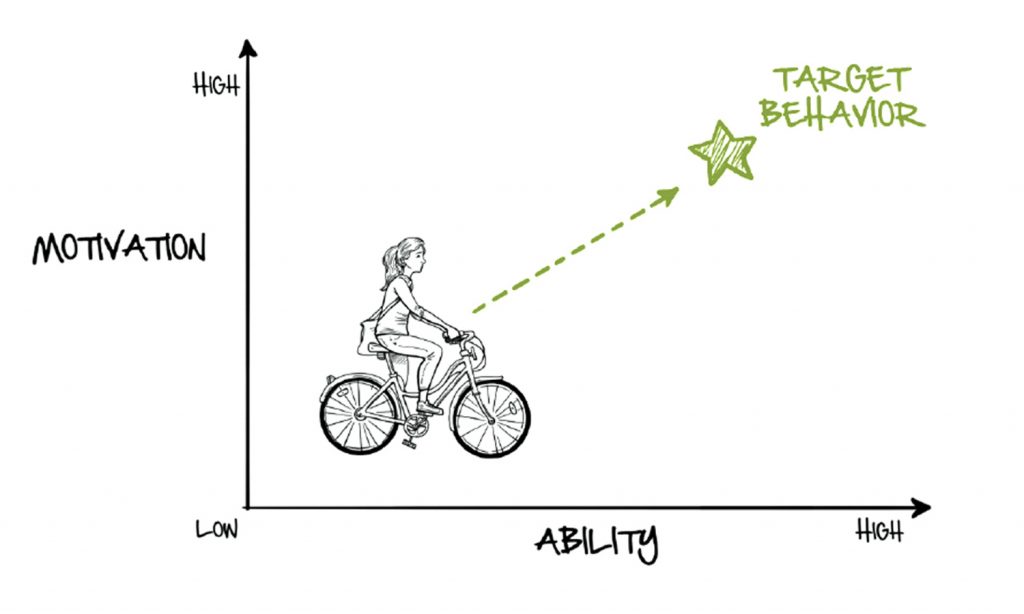changing lifestyles
Exercise
Green Persuasion
 Time Estimate: 1–4 hours
Time Estimate: 1–4 hours
 Goal: Brainstorm persuasive design strategies to solve one of your Design Brief sustainability priorities.
Goal: Brainstorm persuasive design strategies to solve one of your Design Brief sustainability priorities.
Step 1: Brainstorm designs to change user behavior
 Time Estimate: 30–60 minutes
Time Estimate: 30–60 minutes
Hold a brainstorm session, using the Rules of Brainstorming, to generate ideas for reducing your product’s impacts by changing the user’s lifestyle. Choose one of your Design Brief priorities to focus on.
Instead of brainstorming on your system map, brainstorm on the Persuasive Design Quick Reference Guide. Your brainstorm should:
- Have at least two ideas per “increase ability” and “increase motivation” strategy (30+ ideas total.)
- Have some “microsuasion” ideas, where persuasion is a small feature in a larger product (e.g., in Google Maps, there are buttons for transit or biking directions, but the app is used for much more.)
- Have some “macrosuasion” ideas, where the sole purpose of the product is to persuade you (e.g., Quitnet.com, a website dedicated to helping people stop smoking.)
- Focus on the design of your product or service’s user experience itself. It can include revised product design, or an auxiliary product or service such as user interactions with packaging, customer support, retail environment, additional devices, etc. Don’t be afraid to add new functionality to your product!
- Do not count sales or marketing campaigns. Keep your focus on the product and user experience.
Step 2: Narrow down your brainstorm options to three or four winning ideas
 Time Estimate: 5–30 minutes
Time Estimate: 5–30 minutes
Using common sense or whatever tools you desire, narrow down your two brainstorm to just three or four candidates. Judge them by your Design Brief for both sustainability and business criteria.
Step 3: Estimate idea impacts, and choose one final idea to move forward with
 Time Estimate: 15–120 minutes
Time Estimate: 15–120 minutes
Estimate the improvement in impacts of your winning ideas using LCA, an eco-label scorecard, or other quantitative analysis (even simple decision matrix). Use the results to decide on a final idea to more forward with. (You could also decide to pursue multiple winners, or combine ideas.)
Illustrate the final idea with a rough sketch, storyboard, or fancy rendering to clearly convey the idea and its benefits.
Step 4: Document your decision and brainstorm
 Time Estimate: 20–60 minutes
Time Estimate: 20–60 minutes
Create a PDF showing the winning design(s), and the reasons for your choice.
- Show your brainstorm, making it clear that you had at least one idea per persuasive strategy.
- Show the illustration of the final winning design(s).
- Succinctly describe the final winning design, either as annotations to the illustration or as a standalone sentence or two. Describe why it is the best of all your new ideas.
- List or show sketches of the other winning designs.
- Show the analysis you did to choose the final design.
- State how much you expect the winning design to improve ecological impact compared to the original design.
Checklist for Self-Assessment
To score your success on this exercise, see if you…
- Listed 30+ ideas, at least two ideas per “increase ability” and “increase motivation” strategy.
- Had some “microsuasion” ideas, some “macrosuasion” ideas.
- All ideas are for your product or service’s user experience itself, not marketing or advertising.
- Had illustration & description of the final winning design(s).
- Showed analysis to choose final design.
- Calculated estimate for improved impact of the final design(s) compared to the original design.
- Had sketches or summaries of runner-up designs.
All VentureWell Tools for Design and Sustainability content is shareable and usable by CC BY-NC-SA 4.0 license.
